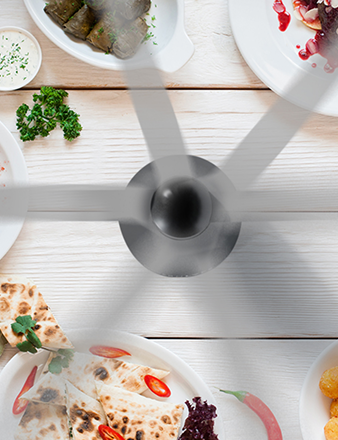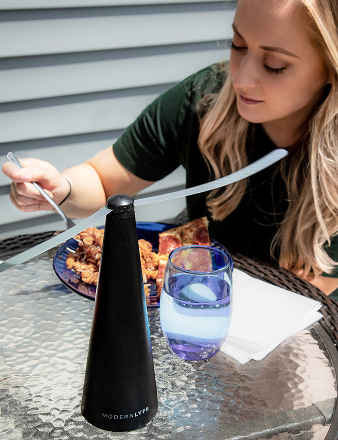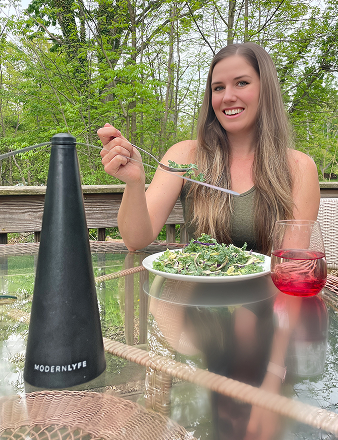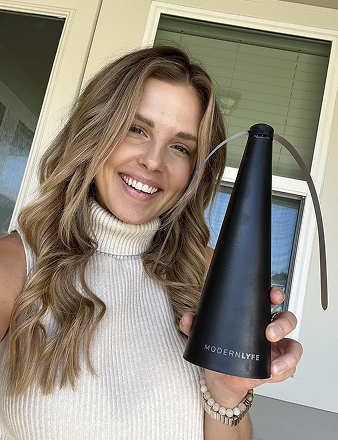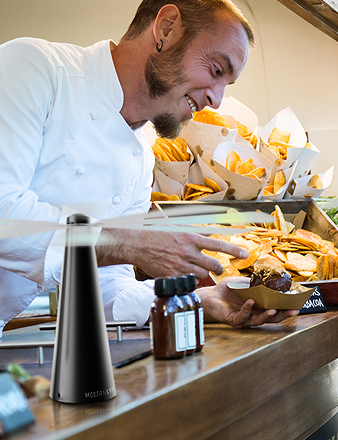You bring home fresh fruit, and suddenly, a cloud of tiny, buzzing insects appears. A good fly trap for fruit flies is designed to solve this problem by using their powerful sense of smell to lure them into a trap they can’t escape.
The concept is simple: bait, like apple cider vinegar, tempts the flies into a container they can't exit. It’s an effective solution that uses their own biology against them, turning their greatest strength into a fatal flaw.
Your Guide to Ending Fruit Fly Problems
That swarm over your bananas isn't just annoying—it's a sign to reclaim your kitchen. This guide provides a straightforward plan for choosing and using the right fly trap for fruit flies, so you can finally get rid of them.
First, let's understand the "why." Knowing what makes these pests tick is the first step toward eliminating them for good.
Why Fruit Flies Invade Your Home
Fruit flies are hardwired to find the smell of fermentation. That scent is a dinner bell, signaling the perfect place to eat and lay eggs. They reproduce quickly: a single female can lay up to 500 eggs in her short life, which is how a few flies can become an infestation overnight.
Under ideal conditions, their entire life cycle can be completed in just over a week.
The secret to success isn't just catching adult flies. You have to eliminate their breeding grounds to stop the next generation. This two-pronged attack delivers long-term results.
This guide explains how different traps work so you can choose the best one for your home. We'll cover everything from simple DIY jar traps to powerful commercial options, giving you the knowledge to pick a method that actually works.
So, what makes a trap effective? It comes down to three things:
- A Potent Attractant: Something sweet and fermenting is irresistible. Think apple cider vinegar or overripe fruit.
- An Easy Entry: A funnel or small holes make it easy for flies to get in.
- A No-Escape Design: This is crucial. Once inside, they either drown in the bait or get stuck on a sticky surface.
Once you understand these principles, you can stop guessing and start solving your fruit fly problem.
At-a-Glance Fruit Fly Trap Comparison
To make it clearer, here’s a breakdown of the most common trap types. This quick comparison will help you find the perfect option for your kitchen.
| Trap Type | Primary Mechanism | Ideal Placement | Effectiveness Rating |
|---|---|---|---|
| DIY Vinegar Trap | Lure & Drown | Near fruit bowls, sinks, trash cans | ★★★☆☆ |
| Sticky Traps | Lure & Adhere | Near windows, plants, light sources | ★★★★☆ |
| UV Light Traps | Attract & Capture | Kitchens, pantries, indoor spaces | ★★★★★ |
| Reusable Jar Traps | Lure & Drown | Anywhere fruit flies gather | ★★★★☆ |
Each trap has its place. The best choice depends on the severity of your problem and where the flies are located. Whether you prefer a simple homemade solution or a high-tech approach, there's a trap that fits your needs.
How Modern Lyfe Solutions Can Help
While traditional traps capture adult flies, they don't solve the root problem: eggs and larvae in your drains. This is where Modern Lyfe comes in. Our products complement your traps by targeting the infestation at its source.
Our Fruit Fly Killer isn't a trap; it's a powerful drain treatment. It uses natural ingredients to eliminate the organic buildup in your pipes where fruit flies breed.
Here's how it works with traps:
- Set Your Traps: Place your chosen fruit fly traps around the kitchen to capture the adult population.
- Treat Your Drains: Use the Modern Lyfe Fruit Fly Killer in your kitchen sink, garbage disposal, and other problem drains to wipe out breeding grounds.
- Break the Cycle: By trapping adults and preventing new flies from hatching, you break their life cycle and end the infestation.
Combining a reliable fly trap for fruit flies with a targeted drain treatment doesn't just manage the problem—it eliminates it.
How a Simple Trap Outsmarts a Fruit Fly
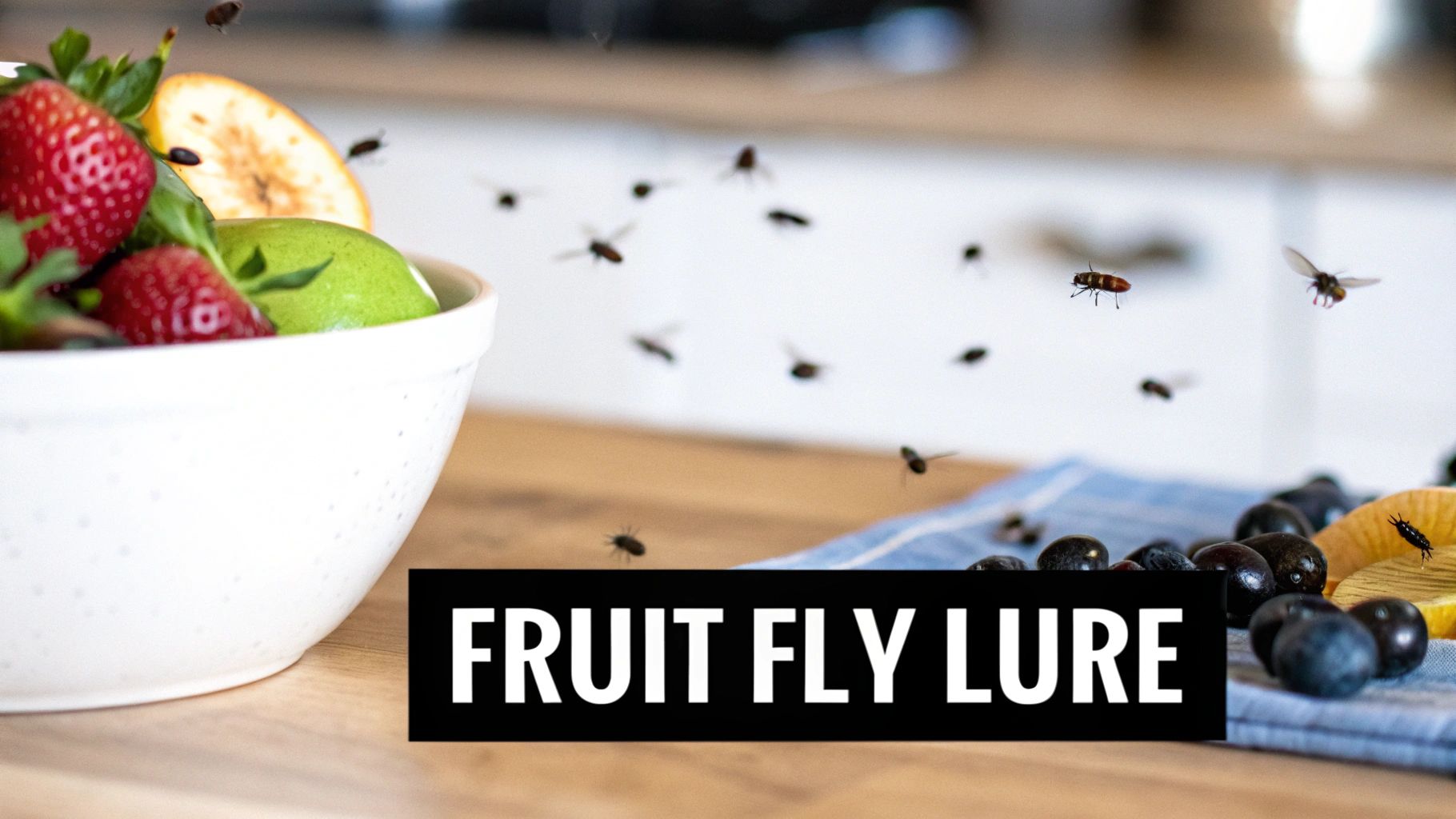
Ever wonder how a jar of vinegar can defeat a swarm of fruit flies? It's not magic; it's smart engineering that uses their biology against them. A good fly trap for fruit flies works by tapping into the instincts these pests use to find food.
Think of it as a tiny diner with a strict "no exit" policy. The trap sends out an irresistible scent that promises a feast, but its design ensures that once a fly checks in, it never checks out. This two-part system of attraction and capture is the secret behind nearly every fruit fly trap.
The Power of Attraction
The heart of any trap is its bait. Fruit flies have an incredible sense of smell, tuned to detect fermenting organic matter. It's why they appear out of nowhere the moment a banana starts to brown.
The smell of fermentation signals a high-energy food source and a perfect place to lay eggs. Traps exploit this by creating a scent that's too good to ignore.
Common attractants that work well include:
- Apple Cider Vinegar: Its sharp, fermented smell is a classic lure.
- Overripe Fruit: A small slice of banana or peach releases the compounds that signal a meal.
- Wine or Beer: The yeast and sugar create an irresistible aroma.
By using these baits, the trap sends a chemical message that pulls flies away from your fruit bowl and into the danger zone.
The Art of the Capture
Once the bait has lured a fly in, the trap’s design takes over to keep it there. The goal is to make entry easy and escape impossible. This is usually done in one of two ways.
The core idea is simple: create an entry that's easy to find but an exit that's impossible to navigate. You're using the fly's own flight patterns against it.
The first approach is the liquid trap. Flies enter through a small opening or funnel, drawn to the scented liquid below. Once they land on the surface, they’re stuck. Adding a single drop of dish soap to the vinegar is a game-changer; it breaks the surface tension, causing the flies to sink immediately.
The second design is the adhesive trap, or sticky trap. These use the same scents to draw flies in, but instead of a pool of liquid, they feature a super-sticky surface. The moment a fly lands, it's caught for good. This method is mess-free and works well, especially near windows or light sources where flies gather.
Comparing the Best Types of Fruit Fly Traps
Choosing the right fruit fly trap isn’t a one-size-fits-all deal. The best choice depends on your specific situation, from the severity of the problem to your kitchen decor. Let's review the most common types to help you find the perfect tool for the job.
The go-to for many is the homemade jar trap. It's simple: a jar, a splash of bait like apple cider vinegar, and a paper funnel or a lid with holes. This is a quick, cheap, and effective fix for a small invasion, perfect for placing next to the fruit bowl.
If you want something more polished, pre-made liquid bait stations work on the same principle but come in a neater package. They’re pre-filled with a potent attractant, so you just unbox and deploy.
Sticky Traps and Electric Models
For those who prefer a liquid-free option, sticky traps are a great alternative. They often come as decorative window stickers or small stakes for houseplants. They use a non-toxic lure on a tacky surface that snags flies on contact. It's a clean, no-fuss way to trap them.
Then there are the heavy hitters: UV light traps. These gadgets use ultraviolet light to attract fruit flies (and other flying insects) and then trap them on a hidden sticky board or suck them into a chamber with a quiet fan. They are more of an investment, but for a persistent problem in a larger space, they are incredibly effective. You can dive deeper into these solutions with our full guide on how to control fruit flies.
This chart gives you a quick visual breakdown of how these popular traps perform.

As you can see, electric traps are the most powerful, but you can't argue with the results from a simple jar trap, especially considering the low cost.
Matching the Trap to the Problem
So, how do you decide? Think about it in these simple terms:
- A Few Annoying Flies: See a couple near the sink? A DIY vinegar trap will likely do the trick.
- A Constant Battle: Always finding them near the pantry or compost bin? A commercial liquid bait station offers reliable, around-the-clock defense.
- A Full-Blown Invasion: When the problem feels like it's taking over, an electric UV trap has the power to get the population under control fast.
The goal is to match the tool to the task. A small, localized problem rarely requires a heavy-duty solution, while a widespread infestation won't be solved by a single, tiny trap.
It's also interesting to see what most people are willing to spend. Affordability is key. The market for traps under $30 is by far the largest, valued at around $289 million and making up nearly 70% of all sales. This shows that you don't need to spend a fortune to get rid of these pests.
Pro Tips for Making Your Traps More Effective

Setting out a fly trap for fruit flies is a good start, but a few tweaks can make it much more effective. You can turn a simple container into a serious pest-fighting machine. The secret is in the details—the things that separate catching a few stragglers from shutting down an infestation.
These tips are all about thinking like a fruit fly. Once you know where they hang out and what they want, you can make your traps irresistible.
Master Your Trap Placement
Placement is everything. A trap on a clean, empty countertop won't do much because that's not where the flies are. You have to put traps in their flight paths and near the places they gather.
Think of it like setting up a concession stand at a festival—you put it where the crowds are.
For the best results, place your traps in these hotspots:
- Near Fruit Bowls: Ripening fruit is ground zero for fruit fly activity.
- Beside the Sink: Drains with gunk and moisture are ideal breeding grounds.
- Next to Trash and Compost Bins: Smells from your garbage are a powerful invitation.
- Close to Houseplants: Damp soil can attract fungus gnats, which are often mistaken for fruit flies.
By placing traps in these key zones, you bring the solution directly to the problem.
Keep the Bait Fresh and Compelling
The bait in your trap is like a fresh-baked cookie—it smells amazing at first but loses its appeal. The sweet, fermented scent that fruit flies love will fade as the liquid evaporates.
A trap with old bait is just a piece of plastic. To keep capture rates high, you must maintain a fresh, potent lure that outcompetes other scents in your kitchen.
Set a reminder to refresh the bait every few days. This keeps the scent strong. If you’re using a homemade mix, add a splash of apple cider vinegar and another drop of dish soap. For store-bought traps, check the instructions on when to replace the lure. A little maintenance goes a long way.
For more bait ideas, our complete guide to choosing the best fruit fly catcher has some great strategies.
Eliminate the Competition and Go All Out
Your trap is competing with every other scent in your kitchen. A browning banana, spilled juice, or crumbs can easily lure a fruit fly away. The best thing you can do is remove the competition.
It comes down to keeping a clean kitchen. Wipe down counters daily, move ripe fruit to the fridge, take out the trash, and clean your sink drain. When your trap is the most interesting thing on the menu, its capture rate will soar.
If you're dealing with a serious problem, use more than one trap. Setting up a few creates a network that catches flies from all corners of the room, reducing their population much faster. This combination of smart placement, fresh bait, and a clean space will get you the results you want.
Common Mistakes That Limit Trap Success

You've set up your fly trap for fruit flies, but the results are underwhelming. The buzzing continues, and you're wondering what went wrong. It's frustrating, but it's almost always due to a simple, fixable error.
Most of the time, we unknowingly sabotage our own efforts. From picking the wrong lure to placing the trap in the wrong spot, these small missteps can make a perfect trap useless. Let's walk through the most common slip-ups so you can get your traps working effectively.
Using the Wrong Bait or Forgetting a Key Ingredient
This is a big one. A common mistake with liquid traps is forgetting one tiny but essential ingredient: dish soap. You can have the most appealing bait, like apple cider vinegar, but without soap, fruit flies can often land on the surface, drink, and fly away. The soap breaks the liquid’s surface tension, so as soon as they touch down, they sink.
Another bait issue is using something that isn't fermented enough. Fruit flies are drawn to the smell of fermentation. Plain white vinegar or fresh fruit juice doesn't have the same pull. Stick with the classics, like rich apple cider vinegar or a piece of overripe banana.
Ignoring the Root of the Problem
Here's the most important thing to remember: traps are a great tool, but they aren't a complete solution. Relying on them alone while ignoring what's attracting the flies is like bailing water out of a boat without plugging the hole. You'll be fighting an endless battle.
A fruit fly trap is fantastic for controlling the adult population, but it's no substitute for good sanitation. To win, you have to take away the things that let them move in and multiply.
This means you have to hunt down their breeding grounds. Pay close attention to these hotspots:
- Overripe Produce: Don't leave ripening fruit on the counter. Put it in the fridge.
- Damp Sponges and Cloths: These offer both moisture and food scraps.
- Sink Drains: Gunk in your drain and garbage disposal is a perfect nursery. Clean them regularly. Our guide on how to repel fruit flies has more prevention tips.
When you tackle the source, you cut the flies off. This proactive approach, combined with a good trap, is your ticket to a fly-free home. It’s no surprise that demand for effective, non-chemical pest solutions is rising. The global fruit fly trap market was valued at USD 150 million and is expected to grow at a 7% CAGR through 2033. You can explore these trends in the full research on fruit fly traps.
Using Traps Alongside Smart Home Prevention
A good fruit fly trap is great for dealing with the current swarm, but to win the war, you need to think bigger. The real secret is pairing your trap with smart, preventative measures.
This approach shifts you from reacting to a fly problem to proactively making your home an unwelcome place for them. The trap catches adult flies, while your preventative tactics cut off their food and breeding grounds. It's a one-two punch that stops the next generation.
Creating a Pest-Proof Fortress
So, how do you build this fly-free environment? It’s all about removing what attracts them. Modern, self-sealing trash cans are a great start. They lock away food scraps and the smells that fruit flies love.
A few other simple upgrades can also make a huge difference:
- Produce Preservers: These storage containers slow down the ripening process, meaning fewer fermented scents to attract flies.
- Smarter Kitchen Habits: It's basic, but it works. Store ripe fruit in the fridge and keep your counters clean to remove the buffet.
The goal is to create a home where pests can't thrive. Use traps to knock down the immediate problem, then use smart solutions to make sure it doesn't return. It's about building a cleaner, more resilient home.
This proactive approach is catching on. The entire fly trap market, including the fly trap for fruit flies, is valued at USD 415 million globally. Experts predict it will climb to USD 623 million by 2030, driven by new tech in UV light traps. If you're curious, you can dig into the full industry report on fly traps to see the bigger picture.
Got Questions About Fruit Fly Traps? We've Got Answers.
Still have questions? You're not alone. Let's clear up some of the most common things people ask when dealing with these pests.
Why Did Fruit Flies Suddenly Take Over My Kitchen?
If it feels like fruit flies appeared overnight, you're not imagining it. A sudden population boom almost always points to a new breeding ground.
The most likely culprit is overripe fruit on the counter, but sometimes the source is sneakier. Think spilled juice under the fridge, a damp sponge, or gunk in your garbage disposal. Find and eliminate that source, and your traps will work ten times better.
It's easy to see why they multiply so fast. A single female fruit fly can lay up to 500 eggs in her short life, and the entire cycle from egg to adult can happen in about a week.
How Long Until My Trap Starts Working?
You should see the first fruit flies investigating your trap within a few hours.
However, seeing a real drop in the population takes more patience—usually several days to a week. The goal is to catch adults before they can lay more eggs. For best results, use a two-pronged attack: keep the traps going while you clean any potential breeding spots. That’s how you break the cycle.
Can I Use the Same Trap for Big House Flies?
Unfortunately, no. A trap designed for fruit flies is useless against larger house flies. It all comes down to their diet.
- Fruit Flies love the sweet, fermented smell of things like apple cider vinegar and decaying fruit.
- House Flies are drawn to a completely different menu of rotting garbage and waste.
That's why a dedicated fly trap for fruit flies is crucial. It uses a bait specifically formulated to attract them.
Take your pest control to the next level with MODERN LYFE. Our innovative solutions help you create a cleaner, more enjoyable home environment. Discover the difference at our website.

